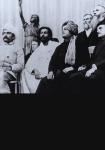I was at Mumbai's domestic airport two days ago, receiving a family member. The flight from Bangalore was predictably late. Information availability at Mumbai's airport (for that matter at most Indian airports) is terrible.
The lack of it is manifested in the utter chaos you witness at terminals. There has been a marginal improvement of late, I suspect.
Late last year, I was sitting at Boston's Logan International airport, waiting for a Jet Blue commuter to New York. My laptop was on. I was using the terminal's high speed Wi Fi connection (not free!).
I was idly browsing through Boston airport's home page. And stopped when a little box on the right side caught my eye. It said 'Airport Monitor'. I clicked on it.
A screen soon opened up with a 90 mile radius map of Boston. I could see Boston Harbor, the Massachussets Bay, Logan International and the airport's five runways, including two parallel ones. And guess what, I could actually see aircraft landing and taking off. Little green aircraft were arrivals and blue were departures. Even helicopters were marked.
This couldn't be, I thought. It looked like real-time radar feed. All the same, I hauled myself to a row of seats facing the giant glass windows and peered through. Past the snow covered tarmac, I could see a steady stream of landing aircraft. I began timing the green guys on my laptop and the real ones that were gliding in. Actually, there was a 10-minute delay (for security reasons). Though after 15 minutes I was convinced I could decipher a pattern.
There was more. I could point my cursor on the arriving or departing aircraft and establish which make they were and at what attitude they were flying at. I clicked on one and it said A320 at 1,900 feet. Another said MD83 at 10,000 feet. I felt like I was king of the air waves. And I could track airborne aircraft all the way south to Newport and Nantucket Sound.
Boston is not alone. Other US airports boast real time feed as well, including Newark, New Jersey and Los Angeles International. The technology is owned by Connecticut-based Megadata.
Passur (Passive Secondary Surveillance Radar), as Megadata's product is called, uses a 'passive' antenna system which monitors 'conversations' between the airport surveillance radar and the aircraft's transponder. So, it's not plugged into the airport's Air Traffic Control, so to speak.
Passur has been around for close to four years now -- Megadata's other airport data analytics products are meant for internal use. Airports offer this for several reasons.
The key objective appears to be to empower residents living around protesting (flight data is stored and retrievable for several months) aircraft noise violations. As also to try and built better, transparent relations with local communities.
Indian airports need a Passur-like solution desperately. Particularly since it may not plug into the ATC. Else, expect howls of protest. And not necessarily for web dissemination -- I can see our security hyper-conscious officials going giddy at the very prospect -- to start with.
May be on large screen TVs at arrival terminals. In addition to the usual bulletin boards. The problem with our information collation and dissemination is clearly the human hand. At best its prone to extreme error and at worst, non-existent.
We need technology to show things as they are. Eliminate both the airport officials and the airlines manual interventions in the process. Save us the agonizing waits. It's not that expensive (around $20,000 a year at one US airport three years ago).
With a few minor modificiations (like displaying the flight number of the aircraft) the privatised avatars of Mumbai and Delhi airport can make a start. And if we can't afford it, we can surely ask our IT folks in Bangalore to reverse engineer something similar.






